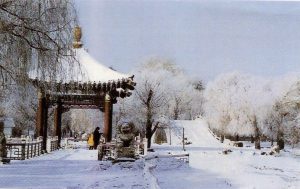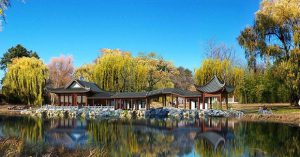Visit the new MN China Friendship Garden Society Website at mnchinagarden.org
The USCPFA-MN China Garden Committee & The Minnesota China Friendship Garden Society proudly announce plans for two Sister-City China Friendship Gardens for the Twin Cities:

Minneapolis Harbin Garden in winter
The Minnesota China Friendship Garden Society proposes to establish two China gardens in the Twin Cities that will:
- be a symbol of Minnesota’s longstanding friendship with China and a recognition of its sister-city relationships
- promote Minnesota’s understanding of China and of China’s rich cultural heritage
- serve as a recognition of the contributions of the Chinese American community to the Twin Cities
- serve to enhance peoples’ connection to and appreciation of nature
- build a cultural bridge that will boost international trade and tourism between China and Minnesota
The Garden, a microcosm where all powers and forces of nature are present, will be an aid to educators as a cultural resource, to global investors in understanding China more broadly, and to the community as a window into China’s rich cultural heritage.
USCPFA-MN China Garden Committee
The China Garden Committee began with the seed of an idea between C.C. Hsiao and Linda Mealey-Lohmann in 2000. Lamenting the fact that at that time there were five Japanese Gardens in the Twin Cities, but no Chinese Gardens, the seed was planted and C.C. and Linda formed the USCPFA-MN China Garden Committee. The goal was to build a China Friendship Garden in Minnesota.
After several years of researching the major China Gardens in the U.S. and Canada, and researching the history, garden and architecture design, and philosophy of China Gardens, Professor C.C. Hsiao and Linda Mealey-Lohmann of the China Garden Committee founded the Minnesota China Friendship Garden Society, a 501(c)(3) organization, in 2006. The mission of the Garden Society is to establish China Friendship Gardens in Minnesota in order to further promote friendship and understanding between the peoples of China and Minnesota.
The Chinese Garden will be a place for: celebration, recreation, education, meditation and aesthetic enjoyment, and will further promote the friendship between the peoples of China and Minnesota.
Philosophy of a China Garden:
- Though man-made, appear as part of nature
- Enhance one’s connection to nature
- Respectful of nature and responsive to human needs
5 Elements of a China Garden:
- Vegetation
- Rocks
- Water
- Scenic pathways
- Architecture – Pavilion, Bridges, etc.
“The wise find pleasure in water; the virtuous find pleasure in hills.â€
(Confucius, Analects)
Chinese gardens have a history of over three thousand years. Â
They present the infinity of nature within a limited garden space; a “landscape painting in three dimensions.â€Â Chinese gardens are composed of natural elements such as flowers, trees, rocks, and water, and man-made elements such as architectural structures, paintings, and poetry. The architectural elements of the garden are intended to focus the viewer’s attention on specific aspects of nature, scene by scene, much like the unrolling of a scroll of landscape painting. “Borrowed scenery†(借景 jiejing) is a key element of Chinese gardens. Taoism also has a strong influence on Chinese gardens, providing a place for contemplation – “involving meditation on the unity of the creation, a creation in which nature possesses a hidden yet real order and harmony, and which may be seen, in moments of enlightenment, through intuitive, tranquil receptivity.â€Â (The History of Gardens, Christopher Thacker, p. 43.) Symbolism through the use of rocks and water, or the placement of flowers and trees, is intentional, yet lacks the symmetry of western gardens.  A Chinese Garden design is both respectful of nature and responsive to human needs.
(excerpt above from US-China Review Winter 2006, “China Friendship Gardens in MN,†)
Importance of China Gardens to Minnesota
- Important Cultural Bridge.  China Gardens will be important cultural bridges to China, which is now Minnesota’s second largest trading partner. These Gardens would further enhance the partnership between China and Minnesota, as such Gardens have done in many cities in the U.S. and Canada. These Gardens would not only add beauty to the neighborhood, but would show the world that Minnesota welcomes international investors and visitors to our global metropolis.
- Recognize Chinese Contributions to MN. The Chinese have a long history in Minnesota, having been here since 1867. They have contributed to Minnesota in many important ways. In the early days to mining, railroad building, restaurants, and laundry businesses, and then to the fields of science, medicine, technology, finance, education, and international trade. Today they are contributing research to many fields, including nanotechnology, bio-fuel, solar energy, Alzheimer disease, etc. The China Garden would recognize their many contributions to the City of Minneapolis, the City of St. Paul, and the State of Minnesota.
- Celebrate MN’s Diversity. Minnesota has many diverse communities. For example, Mayor R.T. Rybak pointed out, in connection with his organizing of the Minneapolis Mosaic Arts Festival, that the City of Minneapolis has 85 languages spoken.  Having gardens related to various ethnicities in Minnesota will help to build better understanding and collaboration among communities, and enhance the partnerships between citizens and their government.
(excerpt above from US-China Review Winter 2006, “MN’s Longstanding Connection to China,†)
Board of Directors
Linda Mealey-Lohmann, Founding Director (with CC Hsiao)
Walter Graff
Barbara Harrison
Jennie Hsiao
Joyce Hsiao
Carole Hyder
Wen Li
Mary Warpeha
To get involved contact:
明州ä¸å›½å‹å¥½èŠ±å›å会

